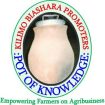Potato farming in Kenya is more than just an agricultural activity; it’s a vital part of the country’s food security and economic stability. With the rise in demand for potatoes both locally and internationally, this humble tuber has become a significant player in Kenya’s agricultural sector. However, like many sectors, potato farming faces a mix of opportunities and challenges. This blog delves into the current state of potato farming in Kenya, exploring the factors contributing to its success and the hurdles that need addressing.
The Importance of Potatoes in Kenya
Potatoes are a staple food in Kenya, often consumed as a side dish or a main ingredient in various traditional recipes. They are a versatile crop that thrives in different climatic conditions, making them a reliable source of food and income for many farmers. In recent years, the demand for potatoes has surged due to population growth and urbanization, increasing the crop’s significance in Kenya’s food supply chain.
The Current State of Potato Farming
- Geographical Advantage: Kenya’s diverse climate allows for the cultivation of potatoes across various regions. The highland areas, particularly in Rift Valley, Kericho, and parts of Meru, are ideal for growing potatoes due to their cooler temperatures and well-drained soils. This geographical advantage enables farmers to produce high-quality potatoes that meet both local and international standards.
- Economic Impact: Potato farming contributes significantly to the livelihoods of rural households. With its relatively short growing period (usually 3 to 4 months), potatoes provide a quick return on investment compared to other crops. This quick turnover helps farmers generate income and manage their financial needs more effectively.
- Innovation and Research: Advances in agricultural research have led to the development of high-yielding and disease-resistant potato varieties. Institutions such as the Kenya Agricultural and Livestock Research Organization (KALRO) have played a crucial role in providing farmers with better seeds and farming techniques. This innovation has helped increase productivity and reduce losses due to pests and diseases.
Challenges Facing Potato Farming
- Pests and Diseases: Despite advancements in research, potato farmers in Kenya still face significant challenges from pests and diseases. The Colorado potato beetle, late blight, and bacterial wilt are among the common issues that can devastate crops and reduce yields. Farmers often struggle with the cost and availability of effective pesticides and disease-resistant varieties.
- Market Access and Prices: Farmers frequently encounter difficulties accessing markets and achieving fair prices for their produce. Price fluctuations and market inefficiencies can lead to financial instability for small-scale farmers. Improving market infrastructure and establishing fair trade practices could help address these issues.
- Climate Change: Climate change poses a growing threat to potato farming. Variations in rainfall patterns, increasing temperatures, and extreme weather events can negatively impact crop yields and quality. Adapting to these changes through better water management and resilient farming practices is essential for sustaining potato production.
- Soil Health and Fertility: Continuous potato cultivation can deplete soil nutrients and affect soil health. Implementing crop rotation, organic farming practices, and soil conservation techniques are vital to maintaining soil fertility and ensuring long-term productivity.
Opportunities for Growth
- Value Addition: There is substantial potential for value addition in the potato sector. Processing potatoes into products like chips, fries, and flour can create new revenue streams and reduce post-harvest losses. Investing in processing facilities and promoting local industries can boost the sector’s profitability.
- Export Markets: Expanding into international markets offers opportunities for Kenyan potato farmers to diversify their income sources. By meeting international quality standards and exploring export partnerships, Kenya can enhance its presence in the global potato market.
- Training and Support: Providing farmers with training and support on best practices, pest management, and business skills can improve productivity and sustainability. Collaborations between government agencies, NGOs, and private sector actors can facilitate knowledge transfer and capacity building.
- Government Policies: Supportive government policies and investments in infrastructure, research, and subsidies can create a more favorable environment for potato farming. Strategic planning and policy implementation are crucial for addressing the sector’s challenges and maximizing its potential.
Conclusion
Potato farming in Kenya holds significant promise for enhancing food security and economic development. By addressing existing challenges and capitalizing on opportunities, Kenya can transform its potato sector into a more robust and resilient part of its agricultural landscape. With continued innovation, support, and strategic planning, the humble potato can become a cornerstone of Kenya’s agricultural success story.



